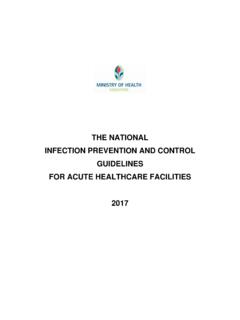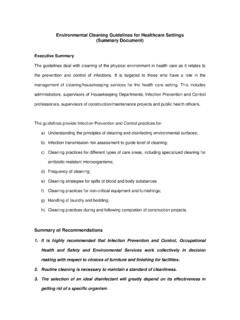Transcription of Management of Poisoning - Ministry of Health
1 Management of PoisoningMOH Clinical Practice Guidelines Dec/2011 Ministry of Health , SingaporeCollege of Medicine Building16 College RoadSingapore 169854 TEL (65) 6325 9220 FAX (65) 6224 1677 WEB 978-981-08-9904-2 College of Family PhysiciansSingaporeSingapore MedicalAssociationPharmaceutical Society of SingaporeSociety for Emergency Medicine in SingaporeToxicologySociety (Singapore)Singapore Paediatric SocietyChapter of Emergency Physicians Academy of Medicine, SingaporeMinistry ofManpowerHealthSciencesAuthorityCollege ofPhysicians,SingaporeDecember 2011 LevelType of Evidence1+ +High quality meta-analyses, systematic reviews of randomised controlled trials (RCTs), or RCTs with a very low risk of bias1+Well-conducted meta-analyses, systematic reviews of RCTs, or RCTs with a low risk of bias1-Meta-analyses, systematic reviews of RCTs, or RCTs with a high risk of bias2+ +High quality systematic reviews of case control or cohort studies. High quality case control or cohort studies with a very low risk of confounding or bias and a high probability that the relationship is causal2+ Well conducted case control or cohort studies with a low risk of confounding or bias and a moderate probability that the relationship is causal2-Case control or cohort studies with a high risk of confounding or bias and a signifi cant risk that the relationship is not causal3 Non-analytic studies, case reports, case series4 Expert opinionGrades of recommendationGradeRecommendationA At least one meta-analysis, systematic review of RCTs, or RCT rated as 1+ + and directly applicable to the target population.
2 OrA body of evidence consisting principally of studies rated as 1+, directly applicable to the target population, and demonstrating overall consistency of resultsB A body of evidence including studies rated as 2++, directly applicable to the target population, and demonstrating overall consistency of results; orExtrapolated evidence from studies rated as 1+ + or 1+ C A body of evidence including studies rated as 2+, directly applicable to the target population and demonstrating overall consistency of results; orExtrapolated evidence from studies rated as 2+ +D Evidence level 3 or 4; orExtrapolated evidence from studies rated as 2+G P P (good practice points)Recommended best practice based on the clinical experience of the guideline development groupLevels of evidenceLevels of evidence and grades of recommendationCLINICAL PRACTICE GUIDELINESM anagement of PoisoningMOH Clinical Practice Guidelines December/2011 Published by Ministry of Health , Singapore16 College Road,College of Medicine BuildingSingapore 169854 Printed by Golden City Colour Printing Co.
3 (Pte.) 2011 by Ministry of Health , SingaporeISBN 978-981-08-9904-2 Available on the MOH website: Statement of IntentThese guidelines are not intended to serve as a standard of medical care. Standards of medical care are determined on the basis of all clinical data available for an individual case and are subject to change as scientifi c knowledge advances and patterns of care contents of this publication are guidelines to clinical practice, based on the best available evidence at the time of development. Adherence to these guidelines may not ensure a successful outcome in every case, nor should they be construed as including all proper methods of care or excluding other acceptable methods of care. Each physician is ultimately responsible for the Management of his/her unique patient in the light of the clinical data presented by the patient and the diagnostic and treatment options summary of recommendations11 Poison Management systems362 Principles of Management of acute poisoning553 Decontamination after poisoning624 Enhancing the elimination of toxic substances from the body755 Antidotes806 Analgesics847 Antihistamines / Anticholinergics1188 Psychotropics1269 Organophosphates15210 Industrial chemicals17111 Caustics / detergents17912 Bites and stings186 Annex A: Commonly-used antidotesAnnex B: Serum toxicity ranges and toxicology laboratory services in SingaporeAnnex C: Socio-psychiatric aspects of poisons managementAnnex D: Resources for industrial chemical exposureAnnex E.
4 Alternative medicine199255265270275 ReferencesSelf-assessment (MCQs)Workgroup membersAcknowledgements281328334336 ForewordIt is estimated that 350,000 people died worldwide from unintentional Poisoning in In Singapore, injuries (including Poisoning ) ranked as the fi fth leading cause of death and the leading cause of hospitalisation from 2007 to 2009. The pattern of Poisoning has changed as the public is now exposed to other new drugs and chemicals. New antidotes and therapies have also been developed for the Management of such Poisoning , and are now available to Health professionals. The Ministry of Health released its fi rst handbook on Management of Poisoning twenty years ago with the objective of providing a quick and reliable reference for the complex Management of drug overdoses / Poisoning . In 2000, a newer edition of the handbook was published to meet the changing needs. This edition of the guideline updates the May 2000 guideline with a greater focus on the principles of emergency Management of Poisoning and the common toxins in the local context.
5 A multidisciplinary expert workgroup reviewed the best available evidence from scientifi c literature and with their expertise in this area, has updated the guideline to assist healthcare professionals in the Management of drug overdoses and Poisoning . I hope this set of recommendations will be useful for healthcare professionals, particularly physicians, pharmacists and clinicians who are involved in the Management and care of patients with drug overdoses and Poisoning . PROFESSOR K SATKUDIRECTOR OF MEDICAL SERVICES1 WHO Data: Poisoning Prevention and Management [Internet]. Th e International Programme on Chemical Safety (IPCS) [cited 5 September 2010]. Available from: 1 Details of recommendations can be found in the main text at the pages of Management of acute Poisoning resuscitating the poisoned patientGPP In a critically poisoned patient, measures beyond standard resuscitative protocol like those listed above need to be implemented and a specialist experienced in Poisoning Management should be consulted (pg 55).
6 GPPD Prolonged resuscitation should be attempted in drug-induced cardiac arrest (pg 55).Grade D, Level 3C Titrated doses of naloxone, together with bag-valve-mask ventilation, should be administered for suspected opioid-induced coma, prior to intubation for respiratory insuffi ciency (pg 56).Grade C, Level 2+D In bradycardia due to calcium channel or beta-blocker toxicity that is refractory to conventional vasopressor therapy, intravenous calcium, glucagon or insulin should be used (pg 57).Grade D, Level 3B Patients with actual or potential life threatening cardiac arrhythmia, hyperkalaemia or rapidly progressive toxicity from digoxin Poisoning should be treated with digoxin-specifi c antibodies (pg 57).Grade B, Level 2++B Titrated doses of benzodiazepine should be given in hyperadrenergic- induced tachycardia states resulting from Poisoning (pg 57).Grade B, Level 1+D Non-selective beta-blockers, like propranolol, should be avoided in stimulant toxicity as unopposed alpha agonism may worsen accompanying hypertension (pg 57).
7 Grade D, Level 3D Physostigmine should be considered for treating tachycardia resulting from pure anticholinergic Poisoning (pg 58).Grade D, Level 3 Executive summary of key recommendations2 GPP Lidocaine is the drug of choice for most ventricular arrhythmias due to drug toxicity (pg 58). GPPC Sodium bicarbonate should be used in impaired conduction defect caused by sodium channel blocking agents such as tricyclic antidepressants (pg 58).Grade C, Level 2+B Titrated doses of benzodiazepine can be used to treat hypertension associated with drug-induced hyperadrenergic states (pg 59).Grade B, Level 1+D High dose vasopressor therapy for hypotension caused by Poisoning needs to be titrated to response and complications (pg 59).Grade D, Level 3D Calcium chloride or gluconate can be given for calcium-channel blocker overdose (pg 59).Grade D, Level 3D glucagon can be given for beta-blocker and calcium-channel blocker overdose (pg 59).Grade D, Level 3D High dose insulin euglycaemia therapy (HIE) is effi cacious for use during calcium-channel and beta-blocker overdose (pg 60).
8 Grade D, Level 3D Life support with circulatory assist device, such as intra-aortic balloon pump and bypass circuits (example: extracorporeal life support system) should be considered in severe refractory hypotension that is unresponsive to maximal medical therapy. Deployment of these devices should be preplanned in advance (pg 60).Grade D, Level 3 GPP For poisoned patients presenting with depressed conscious level due to unspecifi ed drugs, the following treatment should be considered: naloxone, glucose, oxygen and thiamine (pg 60). GPPB Routine toxicology screen for Poisoning agents in the blood and urine or other body fl uids is not advised (pg 60).Grade B, Level 1-3D Checking serum paracetamol level should be considered, especially in a situation of parasuicide where the history may not be forthcoming. Paracetamol is the most common drug involved in parasuicides locally and is readily amenable to treatment with antidotes (pg 61).
9 Grade D, Level 4D Patients, who ingested drugs that are of sustained-release formulation; have a prolonged half-life; or active metabolites that have prolonged effects, should be observed for a longer period of time (pg 61).Grade D, Level 4 Decontamination after poisoningSingle dose activated charcoalC Single dose activated charcoal is indicated as a gastric decontaminant agent if a patient has ingested a potentially toxic amount of a poison up to 1 hour following ingestion (pg 62). Grade C, Level 2+GPP The recommended dose for activated charcoal is as follows (pg 63): Children up to 1 year of age: 10-25 g or 1 g/kg. Children from 1 to 12 years of age: 25 to 50 g or to 1 g/kg. Adolescents and adults: 25 to 100 Activated charcoal can be used with additives like orange juice, chocolate syrup and cola to improve its palatability. However use of these additives may decrease activated charcoal s adsorptive properties (pg 64).Grade C, Level 2-C Use of activated charcoal with cathartics does not improve outcome of gastric decontamination compared to activated charcoal alone (pg 64).
10 Grade C, Level 2-D Use of activated charcoal with other forms of gastric emptying ( gastric lavage) may be indicated in specifi c types of Poisoning where the poison is seriously life-threatening; the dose ingested is of a massive amount; the poison is in a sustained-release preparation; the poison slows gastrointestinal motility (pg 65).Grade D, Level 34C Use of activated charcoal should not be used at home as fi rst aid because its benefi t has not been proven (pg 65).Grade C, Level 2+Gastric lavageC Gastric lavage should not be employed routinely, if ever, in the Management of poisoned certain cases where the procedure is of attractive theoretical benefi t ( recent ingestion of a very toxic substance), the substantial risks should be weighed carefully against the sparse evidence that the procedure is of any benefi t (pg 65).Grade C, Level 2+IpecacC Ipecac has no proven acute role in gastrointestinal contamination Management as there is insuffi cient data to support or exclude its administration soon after poisons ingestion (pg 68).









